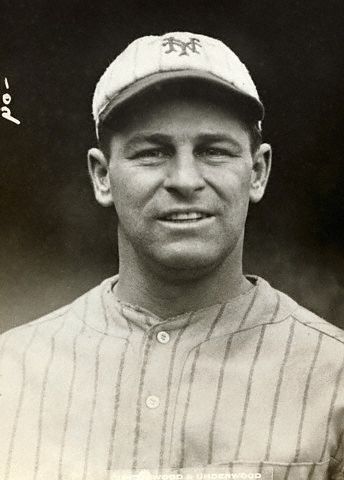Ross Youngs (Royce Middlebrook Youngs)

Ross Youngs reported to spring training in Marlin, Texas with the Giants in 1917. They initially assigned him to the Rochester Hustlers, a team in the International League with which the Giants had a working relationship. Giants manager John McGraw told Mickey Doolan, the manager of the Hustlers, “I’m giving you one of the greatest players I’ve ever seen. Play him in the outfield. If anything happens to him, I’m holding you responsible.” In 140 games with Rochester, Youngs hit .356, earning himself a late-season promotion to the big league club. McGraw gave Youngs the nickname “Pep” due to his hustle and soon began to groom Youngs to become his successor as Giants’ manager. Ross Youngs made his major league debut on September 25 and played in seven of the last nine games of the season for the eventual National League (NL) pennant-winners: six in center field and one in right. In those seven games he went 9-for-26 (.346) with two doubles and three triples. In 1918 regular Giants right fielder Dave Robertson left the team to manage a local military ballclub, and Youngs was given the full-time job out of spring training. Batting exclusively left-handed, Youngs responded by batting .302 in 121 games, finishing sixth in the league. It would be the first of seven straight seasons in which he hit .300 as a regular, and the second of eight overall counting his brief stint in 1917. He also finished sixth in the NL with a .368 on-base percentage (OBP). The next season Robertson was traded to the Chicago Cubs for pitcher Phil Douglas, leaving Youngs to become a fixture in right field for the Giants. Ross Youngs finished third in the NL in 1919 with a .311 batting average. His .351 batting average in 1920 was second in the NL to Rogers Hornsby.
Ross Youngs batted .327 in 1921, good for ninth in the NL. In Game 3 of the 1921 World Series Youngs became the first player to record two hits in the same inning of a World Series game. The Giants defeated the New York Yankees as Youngs batted .280 in the series. Youngs hit for the cycle on April 29, 1922. He finished the regular season ninth in the NL in OBP (.398) and tied for ninth in stolen bases (17), proceeding to hit .375 in the 1922 World Series as the Giants again defeated the Yankees. Youngs led the NL in runs scored in 1923, with 121, and his .348 batting average was the eighth best in the league. Youngs batted .356 in the 1923 World Series, which the Giants lost to the Yankees. Youngs batted .356 during the 1924 season, finishing third in the NL. In the final series of this season, the Giants were playing the Philadelphia Phillies at the Polo Grounds and battling for the pennant with the Brooklyn Dodgers. Jimmy O’Connell, an outfielder for the Giants, offered Phillies shortstop Heinie Sand $500 to intentionally lose the games ($6,904 in current dollar terms). Sand rejected the bribe and reported it to Phillies manager Art Fletcher. It eventually led to the lifetime suspension of O’Connell and Giants coach Crazy Dolan by Commissioner Kenesaw Mountain Landis. O’Connell implicated teammates Youngs, George Kelly, and Frankie Frisch as co-conspirators; Landis, however, cleared the trio of any wrongdoing.
Ross Youngs slumped to a .185 batting average during the 1924 World Series, which the Giants lost to the Washington Senators. Continuing to struggle in 1925, Youngs batted .264, his only season with a batting average below .300, but improved to .306 in 95 games during the 1926 season. Toward the end of his career, Youngs taught Mel Ott, his eventual successor, how to play right field in the Polo Grounds. Ross Youngs’s career was abruptly cut short in 1926 when he was diagnosed with the kidney disorder that, at the time, was called Bright’s disease. He had been exposed to streptococcal infection in 1924. Too ill to play after August 10, 1926, Youngs returned home on McGraw’s insistence and received a blood transfusion in March 1927. Youngs died of Bright’s disease on October 22, 1927 at the age of 30. He went from weighing 170 pounds (77 kg) during his playing career to 100 pounds (45 kg) by the time of his death. In The New York Times obituary, Giants manager John McGraw called Youngs the greatest outfielder he’d ever seen, as well as “the greatest fighter I ever saw on a baseball field” and “the easiest man I ever knew to handle.” The Giants honored Youngs with a bronze plaque on the right field wall of the Polo Grounds; although the Giants intended to pay for it, fans expressed their desire to contribute and, even though contributions were limited to $1 per person, donations paid for the plaque entirely.
Born
- April, 10, 1897
- USA
- Shiner, Texas
Died
- October, 22, 1927
- USA
- San Antonio, Texas
Cause of Death
- Bright's disease
Cemetery
- Mission Burial Park South
- San Antonio, Texas
- USA



